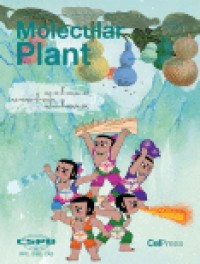Molecular Plant Q1 Unclaimed
Molecular Plant is a journal indexed in SJR in Molecular Biology and Plant Science with an H index of 178. Journal with a Single blind Peer Review review system It has an SJR impact factor of 5,519 and it has a best quartile of Q1. It has an SJR impact factor of 5,519.
Molecular Plant focuses its scope in these topics and keywords: arabidopsis, additivity, alternatively, ambient, arabidopsisgenomewide, architecture, association, chloroplastsgenome, circadian, cyanobacterial, ...
Type: Journal
Type of Copyright:
Languages:
Open Access Policy:
Type of publications:
Publication frecuency: -


- €
Inmediate OANPD
Embargoed OA- €
Non OAMetrics
5,519
SJR Impact factor178
H Index171
Total Docs (Last Year)564
Total Docs (3 years)9661
Total Refs7376
Total Cites (3 years)446
Citable Docs (3 years)13.75
Cites/Doc (2 years)56.5
Ref/DocOther journals with similar parameters
Molecular Cell Q1
Cell Research Q1
Annual Review of Plant Biology Q1
Cell Host and Microbe Q1
Annual Review of Medicine Q1
Compare this journals
Aims and Scope
Best articles by citations
Rice Gene Network Inferred from Expression Profiling of Plants Overexpressing OsWRKY13, a Positive Regulator of Disease Resistance
View moreXA23 is an executor R protein and confers broad-spectrum disease resistance in rice
View moreTargeting of Vacuolar Membrane Localized Members of the TPK Channel Family
View moreErratum
View moreDivergence in the Enzymatic Activities of a Tomato and Solanum pennellii Alcohol Acyltransferase Impacts Fruit Volatile Ester Composition
View moreIGMAP: An Interactive Mapping and Clustering Platform for Plants
View moreThe Chloroplast Kinase Network: New Insights from Large-Scale Phosphoproteome Profiling
View moreMEF13 Requires MORF3 and MORF8 for RNA Editing at Eight Targets in Mitochondrial mRNAs in Arabidopsis thaliana
View moreIron and ferritin dependent ROS distribution impact Arabidopsis root system architecture
View moreRegulation of Seed Germination: The Involvement of Multiple Forces Exerted via Gibberellic Acid Signaling
View moreVanillin - Bioconversion and Bioengineering of the most popular plant flavour and its de novo biosynthesis in the vanilla orchid
View moreSuicidal Co-Degradation of the Phytochrome Interacting Factor 3 and Phytochrome B in Response to Light
View moreRedox-Dependent Regulation of the Stress-Induced Zinc-Finger Protein SAP12 in Arabidopsis thaliana
View moreMild Reductions in Mitochondrial NAD-Dependent Isocitrate Dehydrogenase Activity Result in Altered Nitrate Assimilation and Pigmentation But Do Not Impact Growth
View moreA Comparative miRNAome Analysis Reveals Seven Fiber Initiation-Related and 36 Novel miRNAs in Developing Cotton Ovules
View moreImmunoelectron Microscopy for Locating Calvin Cycle Enzymes in the Thylakoids of Synechocystis 6803
View moreDeletion of a Stay-Green Gene Associates with Adaptive Selection in Brassica napus
View moreIdentification of Arabidopsis MYB56 as a novel substrate for CRL3BPM E3 ligases
View moreGenome-wide Identification and Functional Analysis of Genes Expressed Ubiquitously in Rice
View moreDihydrosphingosine-Induced Programmed Cell Death in Tobacco BY-2 Cells Is Independent of H2O2 Production
View moreMultiplex Gene Editing in Rice Using the CRISPR-Cpf1 System
View moreProfile of Anthony Trewavas
View morePivotal Roles of the Phytochrome-Interacting Factors in Cryptochrome Signaling
View moreA WW Domain-Containing Protein Forms Immune Nuclear Bodies against Begomoviruses
View more
Comments